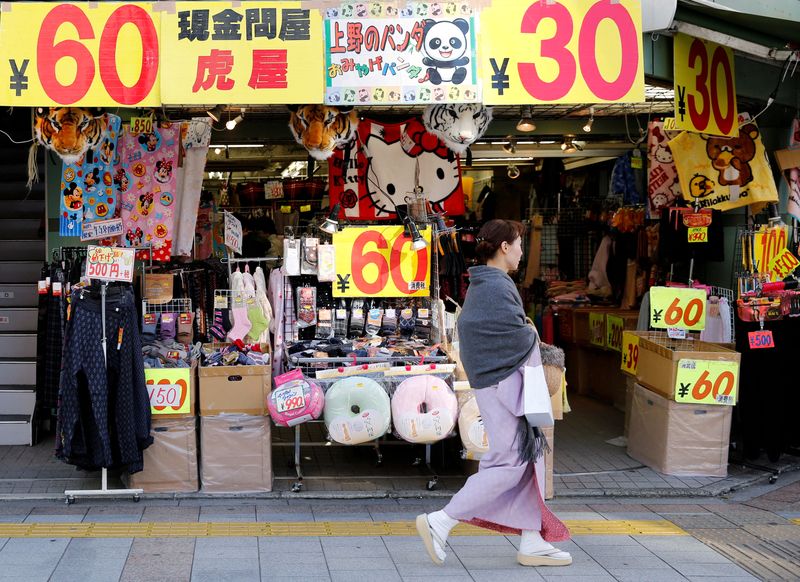By Makiko Yamazaki and Kentaro Sugiyama
TOKYO (Reuters) – Japan’s retailers, typically among the most tight-fisted of employers, are offering big pay increases for a second year in a row, meaning squeezed profits for companies, more spending money for workers, and a green light for more central bank rate hikes.
Japan’s labour-intensive service sector had long managed to avoid making big or sustained pay raises, by tapping a vast pool of part-time, lower-paid retirees and housewives.
But that began to change last year as a rapidly shrinking working-age population and rising inflation made it harder for retailers – who employ 10% of Japan’s workers – to attract and retain staff.
Their acquiescence to successive wage hikes, marking a breakthrough among low-wage service businesses and small manufacturers, has not escaped the notice of policymakers, including central bankers keen for signs that wage growth is taking hold after 25 years of stagnation.
“There was a lot of positive talk on the wage outlook,” Bank of Japan Governor Kazuo Ueda said at a gathering of regional bank executives last week, referencing a meeting of BOJ branch managers the week before.
The central bank has predicated its latest cycle of interest rate hikes, including another expected at a policy meeting later this week, on a sustained “virtuous circle” of higher wages that support higher prices, for services as well as for manufactured goods.
UA Zensen, a group representing retail, restaurant, textile and other industry unions, is seeking wage hikes of 6% for full-time workers and 7% for part-timers for 2025, outpacing the baseline 5% target set by Rengo, the nation’s largest union.
Talks over 2025 wage levels typically conclude around March, and go into effect up to a few months afterwards.
“Solid wage hikes will help put the Japanese economy on a growth track,” said Tamon Nishio, UA Zensen’s general secretary.
“Many of our union members are from small and medium-sized firms and are part-time workers. We want wage hike momentum to spread broadly to our members to achieve real wage growth and create a positive cycle for the economy.”
Economists and executives, however, point to a number of doubts and potential downsides with this momentum, including rising costs for retailers and uncertainty whether workers would be willing to spend their windfall.
“The big pay hikes will boost our cost burden,” Takaharu Iwasaki, president of Japan’s largest food supermarket chain Life Corp, told reporters.
“But with competition to hire and retain workers intensifying, we want to reward them with solid pay.”
The company is targeting wage hikes in 2025 similar to the previous year’s 5% for regular employees and 6% for part-timers.
Retail conglomerate Aeon is also considering raising hourly pay for the group’s 420,000 part-timers by 7%, the same pace as last year.
“We want to continue raising pay mainly for part-timers as we did last year and the year before,” Executive Officer Motoyuki Shikata said on an earnings call on Jan. 10.
“We’re hearing from field managers that pay hikes over the last two years have helped hire workers.”
DOUBTS AND DOWNSIDES
These wage increases are beginning to make themselves felt in retailers’ bottom line.
At Life, labour costs rose 7.9% and net profit fell 3.4% in the nine months through November. Aeon slipped into a net loss in the same nine-month period, with wage hikes increasing its labour costs by 42.7 billion yen ($270.6 million).
The retailers have had little choice, as Japan’s working-age population continues to shrink from its peak of 86 million marked in 1995. A government think tank projects the population between the ages of 15 and 64 will drop about 20%, to 62 million, in the two decades through 2040. The pool of potential part-time female and older workers is also shrinking.
Additionally, there are doubts as to whether wage increases would translate into higher spending, especially with inflation tending to outpace wage growth. Without higher spending, companies would find it difficult to raise prices.
“Retailers are raising wages to retain workers, but it’s questionable whether they can keep doing so beyond this year,” said Shinichiro Kobayashi, principal economist at Mitsubishi UFJ (NYSE:MUFG) Research and Consulting.
“Consumers did accept a certain degree of post-pandemic price hikes at retailers. But there are emerging signs they are getting tired of unabated price rises and shifting to discount stores for shopping,” he said.
Indeed, workers do not appear to be in a spending mood.
“Our cost-saving mindset is so strong, I don’t think higher pay would change people’s spending pattern that much,” said Miwako, a part-time worker at a major supermarket chain in Tokyo who asked to be identified only by her first name.
She said that, while she is hopeful her pay will keep rising, she would plan to save any pay raise rather than spend it.



